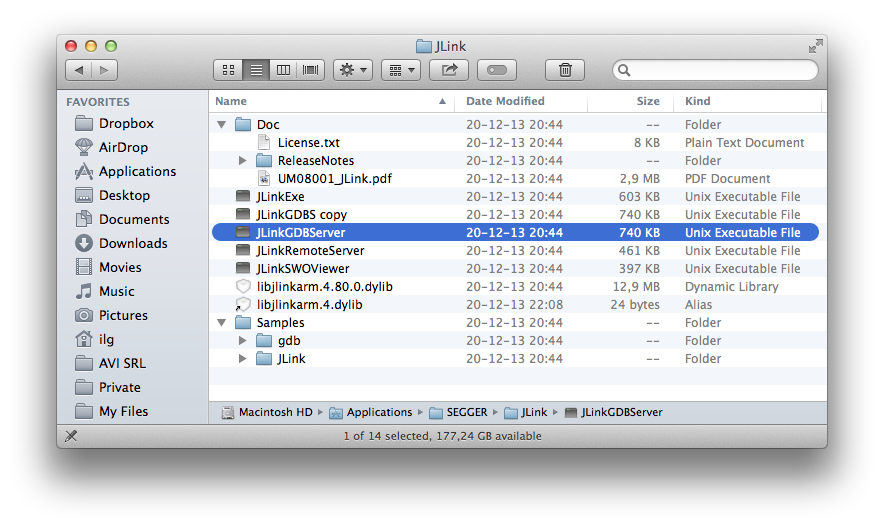A family of Eclipse CDT extensions and tools for GNU ARM & RISC-V development
Contents
Why J-Link?
In case you wonder why GNU MCU Eclipse decided to provide support to SEGGER J-Link, the short answer is: because of J-Link EDU and of SWO. The long answer may include the following:
- wide processor support (there is probably no unsupported ARM processor in the entire galaxy, and if you find one in a remote quadrant, I’m pretty sure it’ll be shortly added to the list)
- it is a true multi-platform solution, providing drivers for Windows, macOS and GNU/Linux
- it comes with a standard GDB server implementation, compatible with existing ARM toolchains
- in addition to the classical JTAG protocol, it implements the new SWD protocol
- when SWD is selected, it is capable to sample the SWO pin, for trace messages and other ARM specific debugging
- it is fast, up to 15 MHz for JTAG clock and up to 7.5 MHz SWO sampling frequency for the new V9 hardware (12 MHz JTAG / 6 MHz SWO for V8, and even up to 100 MHz SWO for the high-performance ULTRA+, PRO models)
- it supports all possible target voltages, from 1.2V to 5V
- in addition to the regular debugging functionality, it is also able to write the internal flash, and, even more, it uses a smart flash writing algorithm, to avoid useless writes if the flash blocks did not change
- it is a mature, proven product, with a great support team
- it provides an entire range of probes, J-Link, J-Link Pro, including a special priced version for educational use, the J-Link EDU (available from many distributors, for example from Farnell)
The J-Link was present on the JTAG market for many years, but, considering the initial prices, only the big companies could afford them. After a fierce fight against Chinese clones, sold for a fraction of the price, in 2012 SEGGER decided to introduce a low price version, J-Link EDU, restricted to educational and non-commercial usage, making it the JTAG probe of choice for open source GNU ARM development.
Overview
J-Link comes not only with a GDB server, but with a complete set of drivers and utilities, packed by SEGGER separately for each platform. The same distribution includes drivers for all J-Link probes, so installation is quite simple. The J-Link binaries are available from the SEGGER site.
There are different sections, grouped by platform (Windows, macOS, Linux, Linux ARM); go to the platform of your choice.
Click the Download button close to the Software and documentation pack appropriate for your development platform. For Linux there are separate 32/64-bit versions, packed with different tools (DEB, RPM, TGZ); select the package that better matches your system.
Accept the terms of the software agreement and download the software.
Documentation
The J-Link GDB server is documented in the UM08001 manual, available from the SEGGER J-Link page.
Windows
The Windows file is a ZIP archive, named like Setup_JLinkARM_V480.zip . After unpacking it, a Windows executable file is obtained, named like Setup_JLinkARM_V480.exe .
- double click it to start the installation process
- enter the administrative password
- accept the license
- accept the destination folder ( C:Program FilesSEGGERJLinkARM_V480 )
- accept the default USB driver
The result of the install is a folder (a new folder for each new version installed), and a set of driver files installed in the system folders, overwritten with each new install.

Please note that on Windows, SEGGER prov >CL ) for most of their tools. For the J-Link plug-in it is recommended to use only the command line version of the J-Link GDB server ( JLinkGDBServerCL.exe ).
macOS
The macOS download is an macOS package installer, like JLink_MacOSX_V480.pkg .
- double click it to start the installation process
- accept the license
- enter the administrative password, required to write in the global /Applications folder
The result of the install is a folder like /Applications/SEGGER/JLink_V641b/ (a different folder for each version) where all executables and libraries are stored; please note that, as for many macOS applications, no other driver files are installed in the system folders, but some symbolic links are created in the /usr/local/bin folder.
Be sure to update the path in Eclipse preferences page to point to the latest SEGGER J-Link software.

On macOS, the USB subsystem automatically identifies and allows access to USB devices, without the need to maintain a manual list similar to the one used by UDEV in GNU/Linux. No other drivers or system configurations are required.
GNU/Linux
As already mentioned, there are multiple packages available for GNU/Linux on the SEGGER download site, built as Debian/Red Hat packages, in 32/64-bit versions, or plain TGZ archives. Select the one appropriate for you system and use the specific tools to install the package. For example, on Ubuntu, to install the 64-bit .deb file, use the following command:
The J-Link executables are installed in /usr/bin .
In case you have a 64-bit machine and install the 32-bit SEGGER package, you might need several 32-bit libraries, depending on distribution.
The install procedure automatically adds /etc/udev/rules.d/99-jlink.rules to define the USB IDs of the J-Link devices. No other drivers are required.
Testing
To test if J-Link is able to connect to a specific board, you generally need to specify the interface (JTAG or SWD) and the device name. By default, J-Link GDBServer will try JTAG but if only SWD is wired (which is very common on custom hardware), you would need to specify the interface (-if SWD). The device name is needed for targets which require special handling on connect (e.g. due to silicon bugs which make auto-detection impossible). For a list of available device names, please refer to the SEGGER Supported devices page. Below is an example how to test a JTAG connection to a STM32F103 evaluation board (-device STM32F103RB) on macOS.
On Windows, to start the GDB server, use back-slashes in the path and the CL (command line) version:
On Ubuntu the command is simple:
In all cases, the result should be similar to the one obtained on macOS.
The J-Link plug-in
If you successfully installed SEGGER binaries, you can proceed to the page documenting how to use the GNU MCU Eclipse J-Link debugging plug-in.
Last modified on Mon Jun 4 19:50:15 2018 UTC.
Operating Systems:
Windows XP
Windows XP x64
Windows Vista
Windows Vista x64
Windows 7
Windows 7 x64
Windows 8
Windows 8 x64
Windows 8.1
Windows 8.1 x64
Windows 10
Windows 10 x64
Detailed Description:
Segger J-Link USB Driver 2.70.8.0 64-bit
The driver package provides the installation files for Segger J-Link USB Driver 2.70.8.0 64-bit .
If you consider updating this driver package by Driver Genius, all you need to do is clicking the Update button beside this driver update. Driver Genius will install the driver automatically, smoothly and silently.
Moreover, constantly scan driver updates by Driver Genius or enable the Scheduled Scan function in Options- Schedule to make sure that you will not miss a new release.
About Segger J-Link USB Driver
If you install this package, your device will be properly recognized by compatible systems, and might even benefit from new features or various bug fixes.
Supported Devices:
J-Link 1 driver
J-Link 2 driver
J-Link 3 driver
J-Link driver
Download the latest SEGGER trial versions, eval packages and user manuals!
Please choose a category below for a list of available downloads:
For an easy start and to illustrate the high quality and ease of use of our software products, SEGGER offers ready-to-use trial and eval versions for a variety of evalboards.
Trial versions usually provide the full feature set of a product, but have a limited period of use. SEGGER eval packages are designed to provide you with a complete software package for the specified target hardware and several IDEs. It allows straightforward evaluation of the target hardware, the target compiler and SEGGER’s middleware components. The SEGGER eval software components are provided in library form, whereas the sample applications are provided as source code.

